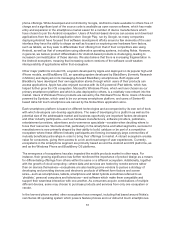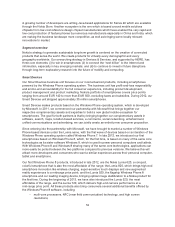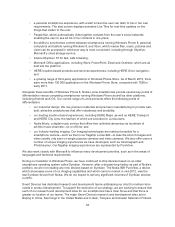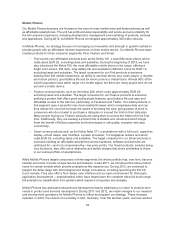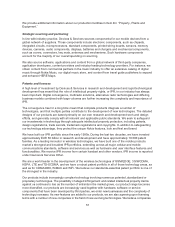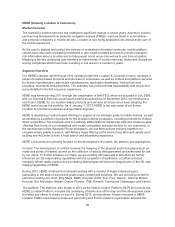Nokia 2012 Annual Report Download - page 51
Download and view the complete annual report
Please find page 51 of the 2012 Nokia annual report below. You can navigate through the pages in the report by either clicking on the pages listed below, or by using the keyword search tool below to find specific information within the annual report.We maintain listings on two major securities exchanges. The listing venues for our shares are
NASDAQ OMX Helsinki, in the form of shares, and the New York Stock Exchange, in the form of
American Depositary Shares.
Our principal executive office is located at Keilalahdentie 4, P.O. Box 226, FI-00045 Nokia Group,
Espoo, Finland and our telephone number is +358 (0) 7 1800-8000.
4B. Business Overview
In November 2012, we introduced a new brand, HERE, for our location-based products and services
and have since been adopting the HERE brand across the portfolio. As of January 1, 2013, HERE is
the new name of our former Location & Commerce business and reportable segment and is used in
the following discussion. The discussion should be read in conjunction with Item 3D. “Risk Factors” and
“Forward-Looking Statements.”
Devices & Services
Market Overview
Communication with a mobile device has become an integral part of the lives of people around the
world. Since the early 1990s, mobile telecommunications penetration has grown rapidly, and today
billions of people own a mobile device. Over the same period, what people can do with their mobile
device has also undergone fundamental change. The development of more capable and smaller
processors and the emergence of the mobile device as a single alternative to an array of one-purpose
products such as music players, cameras and pocketable computers have combined with the growth of
the Internet and more sophisticated network infrastructure to make mobile devices powerful, must-have
consumer products. Demand has also grown for larger handheld Internet-centric computing devices,
such as tablets and e-readers, which trade off pocketability for larger screen sizes. Such devices offer
access to the Internet over WiFi and cellular networks and, like more conventional mobile products, are
increasingly offered in combination with an operator data plan giving the user unlimited or a predefined
amount of data using their device. The growing significance of the Internet in communication has
meant that the mobile telecommunication, computing, consumer electronics and Internet industries are
increasingly converging to form a broader industry encompassing Internet-connected products of
varying shapes and sizes.
With respect to conventional mobile devices, it is still commonplace for the market to be characterized
in terms of feature phones—also sometimes called mobile phones—and smartphones. The distinction
between these two classes of mobile products is typically rooted in their differing capabilities in terms
of software and hardware, the opportunities they provide for third-party application development, the
richness of the experience they offer and the volume of data they process. Historically, feature phones
have been primarily used for calling and text messaging, while smartphones—with the aid of their more
capable operating systems and greater computing power—have provided opportunities to access the
Internet, navigate, record high-definition video, take high-resolution photographs, share media, play
video games and more. Today, however, the distinction between these two classes of products is
blurring. Increasingly, basic feature phone models, supported by innovations in both hardware and
software, are also providing people with the opportunity to access the Internet and applications and, on
the whole, offering them a more smartphone-like experience.
Whether smartphones or feature phones, mobile devices geared for Internet access and their
accompanying Internet data plans are also becoming increasingly affordable and, consequently, they
are becoming attractive to a broader range of consumer groups and geographic markets. A notable
recent development has been the increased affordability of devices based on the Android platform,
which has enabled some vendors to offer smartphones for below EUR 100, excluding taxes and
subsidies, and thus address a portion of the market which has been dominated by more basic feature
50













